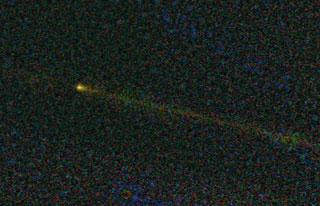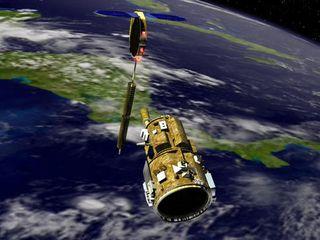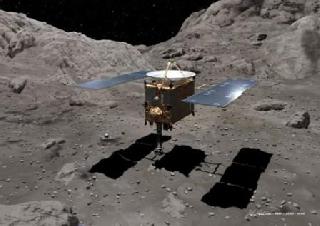
comet Hartley 2 captured by NASA's Wide-field Infrared Survey Explorer, or WISE. Photo by: NASA/JPL-Caltech/UCLA.
PASADENA, CALIFORNIA (BNS): NASA's Wide-field Infrared Survey Explorer, or WISE, caught a glimpse of the comet that the agency's EPOXI mission will visit in November.
The WISE observation will help the EPOXI team put together a large-scale picture of the comet, known as Hartley 2.
"WISE's infrared vision provides data that complement what EPOXI will see with its visible-light and near-infrared instruments," James Bauer, of NASA's Jet Propulsion Laboratory, was quoted as saying in a news release.
WISE's infrared vision will allow the telescope to get a new estimate of the size of the comet's nucleus, or core, as well as a more thorough look at the sizes of dust particles that surround it. This information, when combined with what EPOXI finds as it gets closer to Hartley 2, will reveal how the comet has changed over time.
WISE captured its view of the comet during an ongoing scan of the sky in infrared light. The space telescope has captured the most extensive view of Hartley 2's trail, the dusty path left by the comet on its repeated journey around the sun.
The mission has been busy cataloguing hundreds of millions of objects, from comets to distant, powerful galaxies.
In late September, it used up its frozen cryogen coolant as expected and began a new phase of its survey. Called the NEOWISE Post-Cryogenic Mission, it primarily focuses on finding additional asteroids and comets.
To date, the WISE mission has observed more than 150,000 asteroids and 110 comets, including Hartley 2.
On Nov 4, the EPOXI mission, which uses the already "in flight" Deep Impact flyby spacecraft, will reach its closet approach to Hartley 2. The spacecraft will examine the dusty, icy body in detail as it flies by, providing the best, extended view of a comet in history.
 Previous Article
Previous Article Next Article
Next Article












The Indian Air Force, in its flight trials evaluation report submitted before the Defence Ministry l..
view articleAn insight into the Medium Multi-Role Combat Aircraft competition...
view articleSky enthusiasts can now spot the International Space Station (ISS) commanded by Indian-American astr..
view article